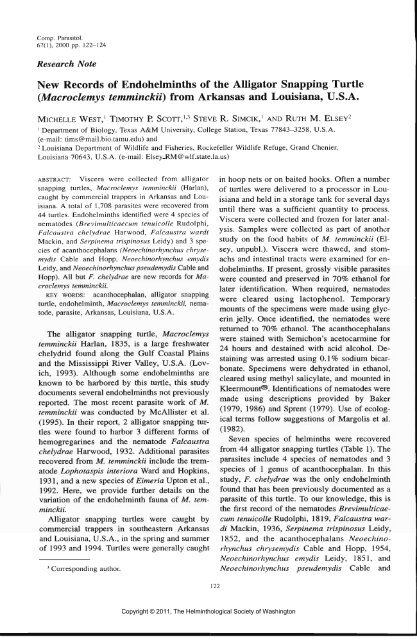Comparative Parasitology 67(1) 2000 - Peru State College
Comparative Parasitology 67(1) 2000 - Peru State College
Comparative Parasitology 67(1) 2000 - Peru State College
You also want an ePaper? Increase the reach of your titles
YUMPU automatically turns print PDFs into web optimized ePapers that Google loves.
Comp. Parasitol.<br />
<strong>67</strong>(1), <strong>2000</strong> pp. 122-124<br />
Research Note<br />
New Records of Endohelminths of the Alligator Snapping Turtle<br />
(Macroclemys temminckii} from Arkansas and Louisiana, U.S.A.<br />
MICHELLE WEST,' TIMOTHY P. SCOTT,'-3 STEVE R. SIMCIK,' AND RUTH M. ELSEY2<br />
1 Department of Biology, Texas A&M University, <strong>College</strong> Station, Texas 77843-3258, U.S.A.<br />
(e-mail: tims@mail.bio.tamu.edu) and<br />
2 Louisiana Department of Wildlife and Fisheries, Rockefeller Wildlife Refuge, Grand Chenier,<br />
Louisiana 70643, U.S.A. (e-mail: Elsey_RM@wlf.state.la.us)<br />
ABSTRACT: Viscera were collected from alligator<br />
snapping turtles, Macroclemys temminckii (Harlan),<br />
caught by commercial trappers in Arkansas and Louisiana.<br />
A total of 1,708 parasites were recovered from<br />
44 turtles. Endohelminths identified were 4 species of<br />
nematodes {Brevimulticaecum tenuicolle Rudolphi,<br />
Falcaustra chelydrae Harwood, Falcaustra wardi<br />
Mackin, and Serpinema trispinosus Leidy) and 3 species<br />
of acanthocephalans (Neoechinorhynchus chrysemydis<br />
Cable and Hopp, Neoechinorhynchus emydis<br />
Leidy, and Neoechinorhynchus pseudemydis Cable and<br />
Hopp). All but F. chelydrae are new records for Macroclemys<br />
temminckii.<br />
KEY WORDS: acanthocephalan, alligator snapping<br />
turtle, endohelminth, Macroclemys temminckii, nematode,<br />
parasite, Arkansas, Louisiana, U.S.A.<br />
The alligator snapping turtle, Macroclemys<br />
temminckii Harlan, 1835, is a large freshwater<br />
chelydrid found along the Gulf Coastal Plains<br />
and the Mississippi River Valley, U.S.A. (Lovich,<br />
1993). Although some endohelminths are<br />
known to be harbored by this turtle, this study<br />
documents several endohelminths not previously<br />
reported. The most recent parasite work of M.<br />
temminckii was conducted by McAllister et al.<br />
(1995). In their report, 2 alligator snapping turtles<br />
were found to harbor 3 different forms of<br />
hemogregarines and the nematode Falcaustra<br />
chelydrae Harwood, 1932. Additional parasites<br />
recovered from M. temminckii include the trematode<br />
Lophotaspis interiora Ward and Hopkins,<br />
1931, and a new species of Eimeria Upton et al.,<br />
1992. Here, we provide further details on the<br />
variation of the endohelminth fauna of M. temminckii.<br />
Alligator snapping turtles were caught by<br />
commercial trappers in southeastern Arkansas<br />
and Louisiana, U.S.A., in the spring and summer<br />
of 1993 and 1994. Turtles were generally caught<br />
3 Corresponding author.<br />
122<br />
Copyright © 2011, The Helminthological Society of Washington<br />
in hoop nets or on baited hooks. Often a number<br />
of turtles were delivered to a processor in Louisiana<br />
and held in a storage tank for several days<br />
until there was a sufficient quantity to process.<br />
Viscera were collected and frozen for later analysis.<br />
Samples were collected as part of another<br />
study on the food habits of M. temminckii (Elsey,<br />
unpubl.). Viscera were thawed, and stomachs<br />
and intestinal tracts were examined for endohelminths.<br />
If present, grossly visible parasites<br />
were counted and preserved in 70% ethanol for<br />
later identification. When required, nematodes<br />
were cleared using lactophenol. Temporary<br />
mounts of the specimens were made using glycerin<br />
jelly. Once identified, the nematodes were<br />
returned to 70% ethanol. The acanthocephalans<br />
were stained with Semichon's acetocarmine for<br />
24 hours and destained with acid alcohol. Destaining<br />
was arrested using 0.1% sodium bicarbonate.<br />
Specimens were dehydrated in ethanol,<br />
cleared using methyl salicylate, and mounted in<br />
Kleermount®. Identifications of nematodes were<br />
made using descriptions provided by Baker<br />
(1979, 1986) and Sprent (1979). Use of ecological<br />
terms follow suggestions of Margolis et al.<br />
(1982).<br />
Seven species of helminths were recovered<br />
from 44 alligator snapping turtles (Table 1). The<br />
parasites include 4 species of nematodes and 3<br />
species of 1 genus of acanthocephalan. In this<br />
study, F. chelydrae was the only endohelminth<br />
found that has been previously documented as a<br />
parasite of this turtle. To our knowledge, this is<br />
the first record of the nematodes Brevimulticaecum<br />
tenuicolle Rudolphi, 1819, Falcaustra wardi<br />
Mackin, 1936, Serpinema trispinosus Leidy,<br />
1852, and the acanthocephalans Neoechinorhynchus<br />
chrysemydis Cable and Hopp, 1954,<br />
Neoechinorhynchus emydis Leidy, 1851, and<br />
Neoechinorhynchus pseudemydis Cable and
















